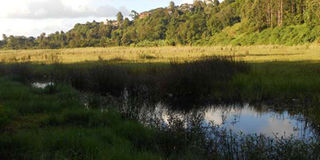Visit Ondiri Swamp for meditation and soothing

Ondiri Swamp near Kikuyu Town. Institutions like schools, hospitals and universities rely on its water. PHOTO | FILE | NATION MEDIA GROUP
What you need to know:
Ondiri Swamp is the source of Nairobi River.
The swamp is a kilometre from Kikuyu Town in Kiambu County and about 500 metres from the southern bypass.
According to hydrologists, the swamp, which stands on a 30-hectare piece of land, is 10 kilometres deep.
Ondiri swamp was named by a white man during colonial times ‘old lake’, which locals corrupted to Ondiri.
The sun rises on the horizon and its rays shine magnificently reflecting the morning dew as we walk on the logs used as bridges at Ondiri swamp.
The swamp is a kilometre from Kikuyu Town in Kiambu County and about 500 metres from the southern bypass.
The bypass begins from Mombasa road, cutting across the length and breadth of Kiambu.
According to hydrologists, the swamp, which stands on a 30-hectare piece of land, is 10 kilometres deep.
Ondiri swamp was named by a white man during colonial times ‘old lake’, which locals corrupted to Ondiri.
QUAKING BOG
The swamp has its natural uniqueness. It is the only quaking bog (wet spongy and shaky ground that has no foundation) in the country and is the second deepest wetland on the continent after another in Doula, Cameroon.
The Nairobi River source has evergreen macrophytes growing above the water.
It also has a reed covered peat consisting partly of decayed plant matter.
Actually over 95 per cent of the bog is covered with papyrus reeds with only about two per cent of the land still covered with indigenous trees. Most have been cut and replaced with eucalyptus trees.
Ondiri Swamp is also a recreation joint as people, especially couples, walk along the breath-taking area enjoying the serenity of the place.
You can walk on the vegetation, but if you jump, the bog “quakes”.
Some people visit this incredible place to dive and swim in the swamp. However, hydrologists do not encourage this.
The swamp serves as an underground outlet to Lake Naivasha and that makes it a perennial bog.
The water from the swamp is used by locals and institutions like Alliance High Schools, Kikuyu Hospital, University of Nairobi-Kikuyu Campus, Presbyterian University of East Africa and Kikuyu Town residents.
Companies constructing the bypass rely on water from Ondiri Swamp.
Many people from various religious denominations flock the swamp as they believe that the water has healing and soothing powers.
It is also a place for meditation.
According to a regional environmentalist, decades ago, deforestation destroyed the ecosystem of the swamp.
Remnants of indigenous trees like acacia, podo and croton have been replaced with eucalyptus, jacaranda, lantanas as well as number of other trees that consume a lot of water.
The environmentalists discourage banana growing that has also been taking place at the edge of the swamp.




